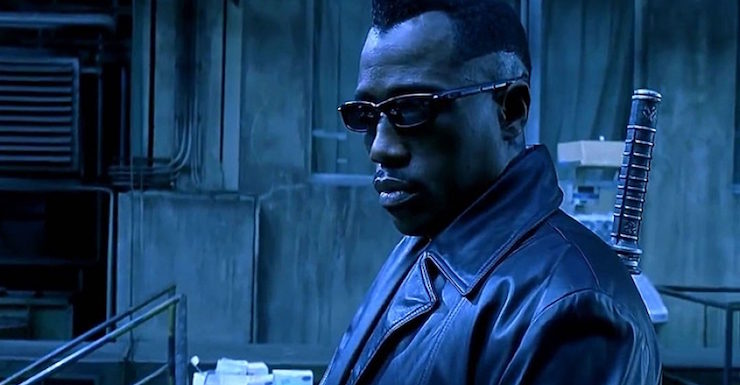One of the most popular comic books during the horror boom of the 1970s was The Tomb of Dracula, which from issue #7 on was written by Marv Wolfman, with art throughout its run by Gene Colan, both grandmasters of the field. Focusing on Marvel’s version of Bram Stoker’s creation (itself inspired by the historical figure of Vlad the Impaler), Tomb of Dracula had as its heroes a collection of vampire hunters, some of whom were members of the Harker and van Helsing family from Stoker’s novel, as well as (among others) a reluctant vampire named Hannibal King and an African-American vampire hunter who simply went by the name Blade.
In 1998, a feature film starring Blade was released, only loosely based on the comic. It was only Marvel’s second actual theatrical release (after Howard the Duck in 1986, also a product of the 1970s comics market), and first success, as the film was a huge international hit, spawning two sequels in 2002 and 2004.
In the comics, Blade was one of a team, who hunted vampires because one killed his mother. He favored knives made of teak (hence the name “Blade”) and also was immune to vampire bites. Preferring to work alone, he did find himself allying with other vampire hunters on a regular basis, even befriending King, despite his being a vampire. (King only drank from blood banks and never took a human life.)
New Line picked up the rights to do a Blade movie in the early 1990s, originally conceived as a vehicle for LL Cool J. David S. Goyer was hired to write the movie, and he moved away from the studio’s notion of a spoof film, preferring to play it straight. Goyer’s wishlist for casting included Denzel Washington, Laurence Fishburne, and Wesley Snipes, with the latter actually being cast. Snipes, a big comics fan—and also a martial artist, so he could do most of the combat scenes himself—took to the role quickly and enthusiastically.
The film version of Blade differed in several respects from the comics version. He was a “daywalker,” a person whose mother was turned while pregnant with him, so he’s an odd halfbreed vampire. He subsists on blood and heals quickly, but he ages normally and can walk in daylight safely. The obsession with hunting vampires remains from the comics, but only select other elements from the comics show up: Deacon Frost in the first movie (as in the comics, it’s Frost who killed Blade’s mother); King and Dracula in the third. However, the huge success of the movies led to the comics character being altered somewhat to more closely hew to Snipes’s version.
Snipes also was a producer of Blade and its two sequels, with Goyer writing all three, and sitting in the director’s chair for the third. Behind-the-scenes difficulties plagued Blade Trinity—Snipes clashed with director Goyer throughout filming, Snipes was under criminal investigation for his security firm the Royal Guard of Amen-Ra, and then in 2006 he was arrested, convicted, and imprisoned for failure to pay his income taxes—which kept there from being a fourth film. However, there was a short-lived TV series in 2006 that aired on Spike in the U.S., based on the films, with Kirk “Sticky Fingas” Jones in the title role. As of 2011, the rights have reverted to Marvel Studios, but nothing has been announced with regard to working Blade into the MCU.
“These people are our food, not our allies”
Blade
Written by David S. Goyer
Directed by Stephen Norrington
Produced by Robert Engelman, Wesley Snipes, & Peter Frankfurt
Original release date: August 21, 1998
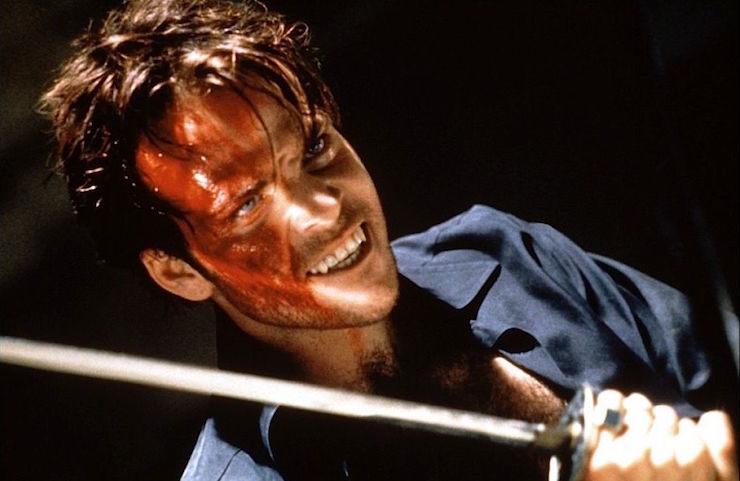
A young woman brings her date to a rave in an underground club in Los Angeles. It turns out to be a vampire club, and the sprinklers spray out blood (there’s a big sign behind the DJ that reads “BLOODBATH”). Blade, a vampire hunter, shows up and, despite there being only one of him and at least a hundred of them, he kills tons of vampires, though most just run away, no doubt frightened by his reputation.
The club is owned by Deacon Frost, and the rave is being supervised by his right hand, Quinn. Blade uses his garlic-filled silver stakes to pin Quinn’s shoulders to the wall and also cuts off one of his hands, then sets him on fire.
The cops arrive, and Blade beats a hasty retreat. He later goes to the hospital to finish off Quinn—who, despite being crispy fried, reawakens in the morgue. He kills a coroner and bites a hematologist. Blade rescues the latter, Dr. Karen Jenson, and brings her to the warehouse headquarters from which Blade and his weaponsmith Whistler are waging their war on the vampires.
Frost is called to a meeting of the vampire elders, where they chastise him for his activities. Things like the rave draw attention to vampires and spoils the harmony they’ve established with humans over the centuries. Frost, though, has little patience for that—to his mind, they’re predators and humans are just prey, not to be catered to and hidden from, but enslaved and eaten.
To that end, Frost has dug up an ancient text that Dragonetti, the head of the elders, says is untranslateable. Frost soon translates it, determining that he can summon the power of the Blood God to himself, but he needs the blood of a daywalker.
Blade and Whistler inform Jenson of the world behind the world, as it were, where vampires exist and exert huge influence over politicians and law-enforcement. Blade himself was born as his pregnant mother was being bitten by a vampire, so he’s an odd hybrid. Whistler treats Jenson in the hopes that she won’t be turned into a vampire, but Jenson takes matters into her own hands, using her mad hematologist skillz to try to find a cure.
Blade takes her home, and then a cop shows up, seemingly to question her about what happened in the hospital, but actually to kill her. Blade then shows up and beats up the cop, though the cop gets away. Jenson is pissed that Blade used her as bait to draw one of Frost’s familiars (a servant who isn’t actually a vampire—Jenson doesn’t realize he isn’t a vampire until the garlic-tinged mace she squirts him with has no effect).
The serum Blade uses to tame his bloodlust is starting to lose effectiveness. Jenson continues to work on a cure, but she also discovers that an anticoagulant, EDTA, has an explosive effect on vampire blood. You inject a vampire with EDTA, the vamp will explode. Blade likes this notion, and adds it to his arsenal.
Reluctantly allowing Jenson to tag along, Blade tracks the familiar to one of Frost’s holdings, a night club, where he finds out about Frost’s big plan. Quinn and Frost’s vampires try to stop him, and Blade cuts off Quinn’s other hand. Whistler shows up with a big van through the wall to rescue them.
Frost kidnaps Dragonetti and exposes him to the sunrise, burning him to a crisp. He also kidnaps the rest of the elders and proposes to Blade that he join him. Blade refuses, viewing Frost not as the messiah Frost believes himself to be, but just another dead vampire. Frost then goes to the warehouse, biting Whistler and leaving him for dead, and kidnapping Jenson, though not until after Jenson has found a serum that cures people who’ve been bitten and turned, reverting them back to human.
Frost’s terms are simple: Blade comes to his penthouse or Jenson dies. Whistler urges Blade to walk away—without Blade, Frost can’t do the ritual—but Blade can’t let Jenson die. He leaves Whistler a weapon with which to blow his own brains out lest he turn into a vampire and then heads to the penthouse.
However, Blade is captured—Quinn shoves stakes into each of his shoulders out of vengeance—and the ritual commences. To Blade’s disgust, one of Frost’s vampires is his mother—he turned her and brought her into his gang, and she’s been a happy vampire for the last thirty years.
Frost starts the ritual, draining Blade of his daywalker blood and killing all the elders, thus giving him the power of the Blood God. Among other things, this means he can’t be killed in the usual manner. (At one point, he’s literally sliced in half, and he puts himself back together without effort.) Jenson manages to free Blade and offers to let him suck her blood to restore his strength. He then takes on Frost, injecting him with several vials of EDTA, which makes him explode. (He also beheads Quinn.)
Jenson offers to cure him, but he needs the gifts his daywalker status gives him to continue his fight, so instead she creates a better serum for him. The next time we see him, he’s taking on vampires in Russia…
“In the end, B, you’re just too human”
Blade II
Written by David S. Goyer
Directed by Guillermo del Toro
Produced by Patrick Palmer, Wesley Snipes, & Peter Frankfurt
Original release date: March 22, 2002
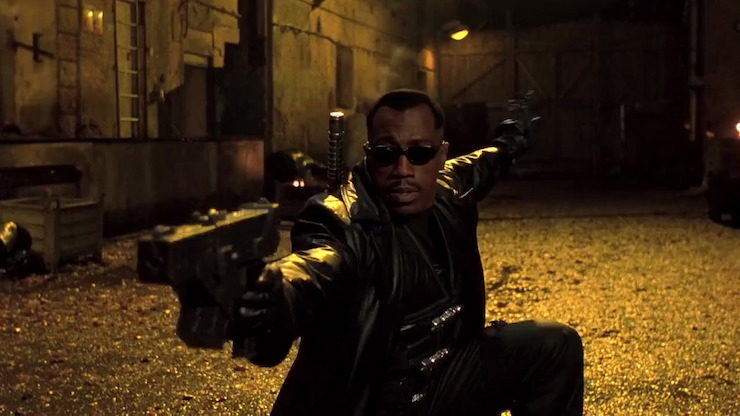
It turns out that Whistler didn’t kill himself when Blade left him with a weapon. Instead, he was kidnapped by the vampire leadership, on the orders of Damaskinos. They tortured him for information, but he never gave anything up. They also kept moving him around, but Blade finally finds him in Eastern Europe and brings him home, curing him of his bloodthirst with Jenson’s cure.
In the two years since Whistler was taken, Blade got a new weaponsmith named Josh, nicknamed “Scud.”
Shortly after Whistler comes home, two vampires, Nyssa and Asad, break into the compound. They’re emissaries, not there for a fight—though they fight anyhow, as this movie never passes up an opportunity for a gratuitous fight scene. Damaskinos wants a temporary truce and alliance to deal with a greater threat: Reapers. Damaskinos tells Blade that they’re the next step in vampire evolution. They have a greater thirst for blood (human or vampire), and they turn their victims almost instantly, not in 72 hours.
Blade is put in charge of the Bloodpack, a strike team of vampires ironically created to deal with Blade. None of them particularly like Blade—though Nyssa and Asad, at least treat him with respect, unlike Reinhardt, who starts right in with racial slurs—and Blade’s response is to go alpha-dog, and also put an explosive device on the back of Reinhardt’s head, to which Blade has the trigger.
Their first stop is a vampire night club in Prague. Sure enough, the “patient zero” of the mutation, Nomak, and a bunch of Reapers show up to chow down. However, it turns out that they’re immune to garlic and silver. The only trick that works on them is sunlight, they’re still vulnerable to that. Blade and the Bloodpack manage to defeat and kill many of the Reapers, though one of the Bloodpack is infected, and they kill him before he can turn completely; another, Lighthammer, is injured. They also capture one Reaper that got stuck and started feeding on itself, showing that the Reapers’s metabolism is so supercharged that they have to feed constantly, which doesn’t say much for the future of the human or vampire races. They bring the Reaper back to Blade’s compound.
Nyssa examines the Reaper, and it turns out its heart is encased in bone, so they’re impossible to stake—except from the side, where there’s a small opening. That will probably be important later. Nyssa is also able to extract pheromones from the Reaper, and the plan is to go into the sewers the next day and lure them in with the pheromones. Scud and Whistler also create a cache of UV flashbangs that will destroy the Reapers—but also the vampires, so they have to be careful.
The vampires dress in full body gear, but leave their heads unprotected because they are played by actors whose faces we need to see, so screw story logic. In the sewers, Lighthammer turns out to be infected, and turns into a Reaper, killing Snowman—Verlaine throws a sewer cover open, sacrificing herself to take them both out. Eventually, all the Reapers are killed, but so are most of the vampires—Asad and Chupa are overwhelmed by Reapers (the latter while beating up Whistler just for the hell of it). Nyssa only survives because Blade lets her feed on him, and Whistler only survives because Nomak deliberately leaves him alive to pass on some intelligence.
It turns out that Nomak isn’t a mutation, he’s an experiment—and also Damaskinos’s son. Nyssa is appalled to realize that her own father sent her and her team on a mission that got most of them killed based on a lie. Whistler is appalled to realize that Scud—whom he was just starting to like—was a mole from Damaskinos all along, as was Reinhardt.
Blade and Whistler are taken back to Damaskinos’s headquarters. Damaskinos still needs to breed vulnerability to sunlight out of his Reapers, and he sees Blade as the key. However, Nomak tracked the team and attacks, taking out his father’s troops all by his lonesome. Whistler uses the distraction to escape and free Blade. This time, Blade regains his strength by diving into the pool of blood that Damaskinos uses, and then beats up a ton of vampires all by his lonesome, ending with cutting Reinhardt from stern to stem.
Damaskinos tries to convince Nomak to rule by his side, but Nomak isn’t having any of that, and kills his old man, then Nyssa—wracked by guilt and anger—lets him infect her. Blade shows up, and he and Nomak fight to the death, with Blade finally winning by stabbing him in the side. Nyssa’s final wish is to die as a vampire rather than a Reaper, so Blade takes her outside to watch the sun rise.
“You might wanna consider blinking once in a while”
Blade Trinity
Written and directed by David S. Goyer
Produced by Wesley Snipes, David S. Goyer, Lynn Harris, & Peter Frankfurt
Original release date: December 8, 2004
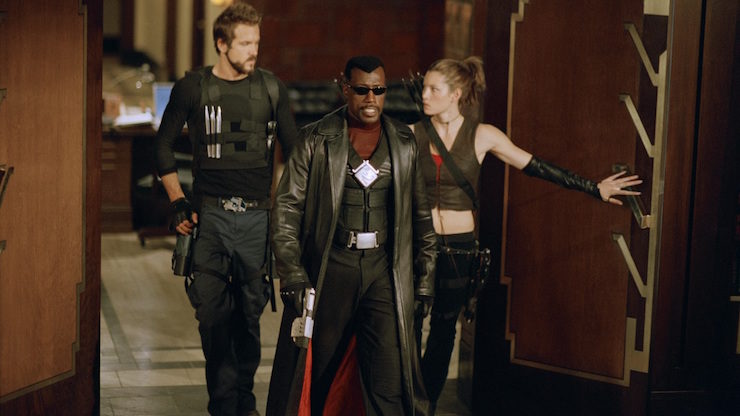
A group of vampires led by Danica Talos travel to Iraq and unearth the tomb of Dracula (ahem), who was the original vampire. The vampires who did that also frame Blade for murder by filming him and Whistler going after a nest of vampires—but one is a human disguised as a vampire, so when Blade kills him, he doesn’t disintegrate into ash.
As it is, Blade is starting to gain a rep from all the familiars he’s killed, as they leave actual corpses behind with evidence on them. Two federal agents have been chasing Blade for quite a while, and they lead a raid on Blade and Whistler’s compound, during which Whistler is killed and Blade is arrested.
A pop psychologist is brought in by the local chief of police to evaluate Blade (both the shrink and the chief were on a chat show earlier in the movie, pooh-poohing the whole notion of vampires while condemning Blade’s vigilantism). Said shrink has Blade committed, with the chief’s support, to the FBI’s annoyance. However, both shrink and chief are familiars to Talos, and she and her gang come in posing as staff from a mental institution.
Blade is rescued by two people, one of whom is Whistler’s daughter. Abby was conceived during a one-night stand after Whistler’s family was killed. Abby tracked her father down and started hunting vampires on her own. She’s gathered a team called the Nightstalkers, which also includes Hannibal King—a former vampire who was cured—and it’s the two of them who rescue Blade.
They bring Blade to their HQ to meet the rest of the team: Hedges, who makes the gadgets, Sommerfield, a blind woman who is their science expert, and Dex, their mechanic. Also present is Sommerfield’s daughter Zoe. Blade is less than impressed with these amateur vampire hunters in general and with King’s smartass attitude in particular, but as they point out, he’s got nowhere else to go.
There’s a bigger issue, too. King and Abby reveal that the original vampire—whom Bram Stoker called Dracula, and who now is going by Drake—has been revived. Talos is hoping that Drake will aid them in eliminating their weaknesses. Sommerfield is also working on a virus that will kill only vampires, and Drake’s blood would make it one hundred percent effective.
Blade, King, and Abby question every familiar they can find until they track down Drake. However, he kicks their asses six ways from Sunday—turns out he can survive in sunlight, and neither silver nor garlic nor EDTA affect him.
King is wounded, and while he recovers, Abby and Blade check out a blood farm that Talos uses—milking homeless people, basically—and take it down, killing the police chief familiar in the bargain.
While they’re gone, Drake attacks the Nightstalkers’ compound, killing Sommerfield, Hedges, and Dex, and kidnapping King and Zoe. Talos wants to convert King back into a vampire, starve him, and then give him Zoe to feed on when the thirst is so desperate he can’t stand it anymore.
However, King reveals that all the Nightstalkers have tracking devices on them, and sure enough, Blade and a very pissed-off Abby (okay, Blade’s pissed, too, but he’s always like that) show up to rescue King—but also to stop Drake. Sommerfield left them a present before she died: a formula for the virus that, when it interacts with Drake’s blood, will turn into an airborne pathogen that will kill any vampire it comes into contact with. They’re only able to make enough to put into one arrowhead, which Abby carries in her quiver.
King is rescued, and has to face off against the dogs that Talos’s people have vampirized as well as Grimwood, while Abby takes out the various redshirt vampires, leaving Drake to Blade. The pair of them start out swordfighting, then move on to hand to hand. Blade holds his own—barely—but nothing he does has any effect on Drake. Abby tries to shoot him with the virus arrow, but Drake catches it and tosses it aside. Blade, however, manages to grab the arrow off the floor and stab Drake with it, killing him and also making the virus airborne and killing everyone else.
Blade seems to also succumb to the virus—Sommerfield had no way of knowing if a halfbreed like Blade would be affected—but while in the morgue, he wakes up and lives to kick ass another day.
“We were gonna go with ‘the Care Bears,’ but that was taken”
First of all, we’ve been hearing a lot the last couple years about how Deadpool was supposedly Marvel’s first R-rated feature and how this weekend’s Black Panther is the first black Marvel superhero to get a movie, when in fact, Blade accomplished both those things already twenty years ago. And we’re not talking an obscure, forgotten film, we’re talking a big international success that spawned two very successful sequels! Good job, entertainment journalists!
In truth, the character Wesley Snipes plays in these three movies bears very little resemblance to the character from the comics. The Blade that Wolfman and Colan created in the 1970s was an engaging smartass, a bit of a loner who nonetheless was devoted to his friends (particularly Hannibal King). Snipes instead has chosen to play him as a stoic hardass who barely changes his facial expression.
It’s maddening because Snipes is one of the most versatile actors out there. He built his reputation on an impressive variety of roles, from comedy in places like Major League and White Men Can’t Jump to powerful drama in New Jack City and Mo’ Better Blues to solid action roles in Demolition Man and Passenger 57. He slid effortlessly from a vicious drug lord in Sugar Hill to a drag queen in To Wong Foo, Thanks for Everything, Julie Newmar. And then he winds up with a part that could—and, honestly, has proven to—be his defining role, and his approach is to give him no personality whatsoever.

What the role does do is give Snipes a chance to show off his martial arts skills. He started training at the age of twelve, and even his action roles haven’t given him the opportunity to show off his skills on film the way playing Blade has. Snipes does his own fight choreography—he’s credited for it in each film, along with Jeff Ward in Blade; Ward, Clayton J. Barber, and co-star Donnie Yen in Blade II; and Chuck Jefferys in Trinity—and it pays off. All three movies are a joy to watch in terms of fight scenes, as the hand-to-hand action is superlative.
In Blade II in particular, that’s all there is to it. All three movies have pretty thin plots, but it stands out in the second one more than the other two, as the first has the world-building and exposition to flesh it out (every vampire story has to establish exactly how vampirism works in this iteration of it), and the third gives us a veritable truckload of Ryan Reynolds snark to keep things moving.
The second movie is often considered the strongest because it has the most famous director, but that’s simplistic to my mind. For starters, The Matrix came out between the first two movies, and the misbegotten influence of that overrated piece of nonsense is all over Blade II. (Yes, I really really dislike The Matrix, why do you ask?) The action and cinematography is tiresomely stylized, far more so than the other two.
And there really isn’t an entire movie’s worth of story here, as evidenced by how little time is spent on the story and how much of it is spent on action scenes. The action scenes are generally pretty good, mind you, but it covers up the thin story, which isn’t even particularly well told. For starters, it takes the wind out of the sails of the story to have Blade work with vampires when Blade himself shows no actual emotion regarding it, by virtue of never showing emotion ever. At least we get Kris Kristofferson’s bitching as Whistler, though that’s annoying, too, because Whistler had a strong and powerful death scene in Blade and they just reversed it totally unconvincingly in Blade II. Lip service is paid to Blade not entirely trusting Whistler and concern that it’ll take him a while to get over the thirst, but absolutely nothing is done with it. Whistler’s just, y’know, back and stuff. And when Scud reveals himself to be a mole, Blade tells us he knew all along and reveals that he fixed the detonator on the bomb he’d attached to Reinhardt—but that makes no sense, as Scud has access to way too much info for that to be safe or smart. Yes yes yes, “keep your friends close and your enemies closer,” but Jesus. Also the grudging respect between Blade and Nyssa has no room to breathe because, again, Snipes plays Blade as a statue.
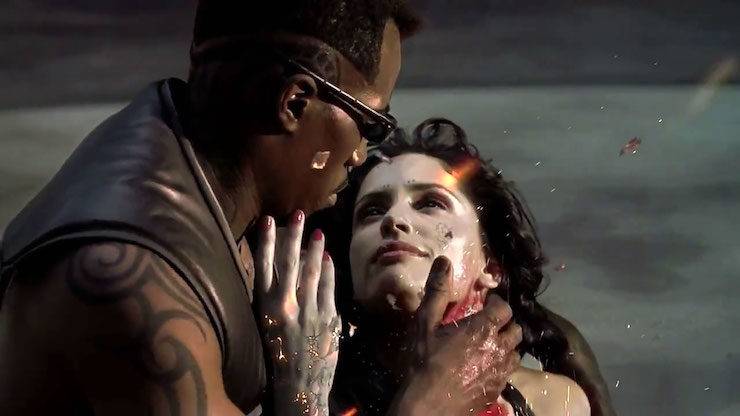
At least Leonor Varela makes Nyssa’s struggles interesting, which is more than can be said for N’Bushe Wright’s lifeless performance as Jenson in the first movie. She’s set up for a return in subsequent films—and you gotta think a hematologist would be a handy ally—but her bland performance means she’s not missed at all in the other two films, and really damages the effectiveness of the first.
So does the choice in villain, which is a problem throughout all three. Neither Stephen Dorff’s flaccid Frost nor Thomas Krestchmann’s Nosferatu-lite Damaskinos nor Dominic Purcell’s utter inability to show depth and nuance as Drake serve the films well. At least they have secondary villains to pick up the slack, from Donal Logue’s batshit crazy Quinn in the first film to the always-brilliant Ron Perlman as Reinhardt in the second movie to Parker Posey vamping it up (sorry…) as Talos in Trinity.
It’s fun to watch these movies two decades later and remember who all was in them. Besides Logue (currently Bullock in Gotham), Perlman (later starring as Hellboy), and Posey (soon to be in Superman Returns), you’ve got Udo Kier (who starred in several vampire films of the 1960s and 1970s) and Judson Scott (Joachim from Star Trek II: The Wrath of Khan) in Blade; Danny John-Jules (Cat from Red Dwarf), Norman Reedus (Daryl from The Walking Dead), and Tony Curran (the Invisible Man in The League of Extraordinary Gentlemen) in Blade II; and Patton Oswalt (the Koenigs on Marvel’s Agents of S.H.I.E.L.D.), James Remar (Gambi in Black Lightning), eternal character actors Christopher Heyerdahl and Callum Keith Rennie, and the aforementioned Reynolds in Trinity.
Seriously, you gotta figure Reynolds just showed a reel of his bits as King in Trinity when he auditioned for Deadpool. “Fuck me sideways!” “You cock-juggling thunder-cunt!” “How about you take a sugar-frosted fuck off my dick?” And so on. Reynolds makes the movie, his barrage of obnoxiousness—not to mention his spectacular ability to take a punch and get beat up well—serving as a nice palliative to Blade’s hyper-competenece and glacier-like mien. This was Reynolds’s first role that wasn’t in a kids program or a goofy comedy, and he really did make the most of it.
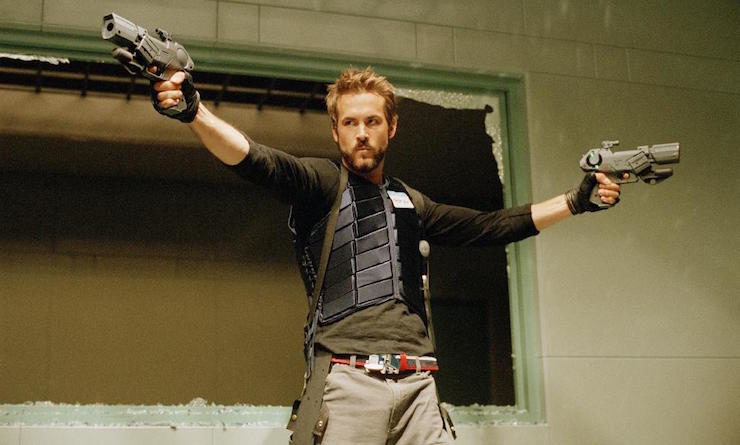
For all that these three movies have issues, though, they’re tremendous fun. The visual effects still hold up twenty years later (which can’t be said for all the movies from this era), and the fight choreography is superb. The vampire lore isn’t going to make anyone gasp with how complex and original it is, or anything, but at least it avoids overcomplicating everything with nonsense (I’m looking at you, Underworld franchise), and it all holds together, more or less. There’s a certain amount of repetition that’s tiresome, though. Two of the three movies have stealing Blade’s blood as a plot point, two of them have major battles in raves, two of them have Whistler dying, two of them have the bad guy throwing a small child at Blade to distract him (really!), and so on.
Most of all, though, this was finally a series of theatrically released movies that Marvel could point to and call a hit. After a string of feature films that either never got released (Fantastic Four), only got released sporadically (The Punisher, Captain America), or never should’ve been released (Howard the Duck), Marvel finally got one of its heroes onto the big screen in a manner that people actually liked and wanted to see more of.
It was a harbinger of things to come, obviously, as the dominoes all started to fall after this. Next week, we’ll look at the next domino, 2000’s X-Men.
Keith R.A. DeCandido is a guest at Planet Comic-Con in Kansas City this weekend. He’ll be at the Bard’s Tower table all weekend. Other guests include Justice League’s Jason Momoa, definitive Batman voice Kevin Conroy, fellow authors Melinda M. Snodgrass, Dayton Ward, Kevin Dilmore, Kevin J. Anderson, Quincy J. Allen, and Michelle Corsillo, plus a crapton of other actors, writers, comics creators, and more. More details on Keith’s blog, including the two panels he’s doing.










